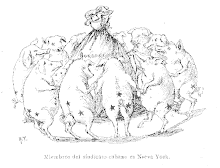Louisianans have dealt with the commercialization of Mardi Gras pretty well. Initially at least, I considered it something of a complement to see Mardi Gras parades in cities that had absolutely no business hosting them. It was fine when audience members at the Jerry Springer show were encouraged to throw purple, green and gold beads at the half-naked freak show on the stage. I can even tolerate the bottles of Cajun hot sauce and cans of Cajun Spice made in Cleveland. I can stomach Cajun burritos, Cajun McChicken sandwiches, Cajun chicken salads, and all the other commercialized insults to my cultural heritage. Alone, they’re not that bad.
But what I absolutely refuse to accept are the far too many “Cajun” restaurants that sell food no Cajun would ever eat. Where do they come up with these menus? What self-respecting Cajun would ever make a vegetarian gumbo? What white rubber boot-wearing Coonass would dare to dip his spoon into a tofu ettouffee? Since when does an over-spiced leg of chicken constitute Cajun food?
And there are countless other examples. A few years ago I passed a small restaurant in Boston’s South Station that sold boiled crawfish by the half dozen—THE HALF DOZEN!!!! What the fuck are you going to do with six crawfish?
Some people might not understand my sensitivity here. Why, you might be asking, would this fool be so offended by bad Cajun food? Well, let me explain. Until relatively recently, the name “Cajun” was something of a derogative term, even in Louisiana. By the early 20th century, French had effectively vanished from the few cities and urban areas in Louisiana. And, as happens in many places where the vernacular is neither the language of politics nor of business, French was relegated to the countryside. French was the language of the uneducated; and “Cajun” was the term used to describe the “stupid,” “illiterate,” “rice-farming,” country-bumpkins of Louisiana. It’s a sad fact, but Cajuns have been the victims of a very successful form of cultural extermination. My grandmother—a French-speaking child of two illiterate Cajun peasants—was beaten in school each time she spoke in her mother tongue. And this was no isolated incident. Most families in Louisiana, at least those that can claim even an ounce Cajun heritage, tell stories like this one. Like my grandmother, the few remaining true Cajun French speakers will be gone in just a few years—gone FOREVER!!
So it’s with a strange mixture of disgust and acceptance that I tolerate the ham-fisted, over-commercialized celebration of Cajun culture. But it’s more than a little insulting that any dish can become Cajun with just a touch of black pepper or a side of rice.
Several years back there was an attempt by some eccentric Louisiana legislators—God bless ‘em—to demand that any product sold in the country with the name “Cajun” in the title include some ingredient actually from Louisiana. This attempt was ridiculed at the time. And, I must be honest, I don’t remember thinking it a very wise move myself. But, consider how New Englanders would feel if cans of brown gruel swimming with unidentified seafood chunks were sold all over the country under the label “New England Clam Chowder.” How would Koreans feel if grilled ham sandwiches were sold as 삼겹살? Shit!!, how do Mexicans feel about Taco Bell? I don’t know. But I can’t imagine they’re particularly happy about it.
I don’t know where I’m going with this. But, most Irish bars in New York City actually have Irish people working there. Most Chicago-style pizza restaurants actually sell Chicago-style pizza. Is it too much to ask that a purportedly Cajun restaurant either serve Cajun food (and by this I mean food that people in South Louisiana actually eat) or, and this would be clever, hire a few random Coonasses to work the bar? Maybe it is. I don’t know.
In case anybody is wondering what real Cajun food actually looks like:









No comments:
Post a Comment